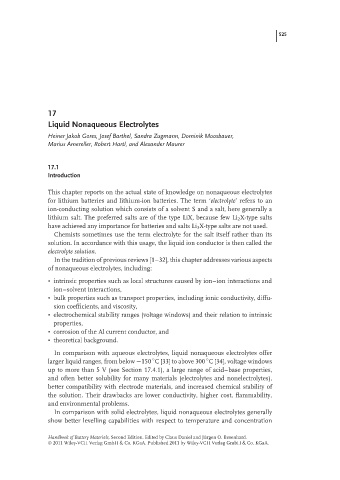Page 551 - Handbook of Battery Materials
P. 551
525
17
Liquid Nonaqueous Electrolytes
Heiner Jakob Gores, Josef Barthel, Sandra Zugmann, Dominik Moosbauer,
Marius Amereller, Robert Hartl, and Alexander Maurer
17.1
Introduction
This chapter reports on the actual state of knowledge on nonaqueous electrolytes
for lithium batteries and lithium-ion batteries. The term ‘electrolyte’ refers to an
ion-conducting solution which consists of a solvent S and a salt, here generally a
lithium salt. The preferred salts are of the type LiX, because few Li 2 X-type salts
have achieved any importance for batteries and salts Li 3 X-type salts are not used.
Chemists sometimes use the term electrolyte for the salt itself rather than its
solution. In accordance with this usage, the liquid ion conductor is then called the
electrolyte solution.
In the tradition of previous reviews [1–32], this chapter addresses various aspects
of nonaqueous electrolytes, including:
• intrinsic properties such as local structures caused by ion–ion interactions and
ion–solvent interactions,
• bulk properties such as transport properties, including ionic conductivity, diffu-
sion coefficients, and viscosity,
• electrochemical stability ranges (voltage windows) and their relation to intrinsic
properties,
• corrosion of the Al current conductor, and
• theoretical background.
In comparison with aqueous electrolytes, liquid nonaqueous electrolytes offer
◦
◦
larger liquid ranges, from below −150 C [33] to above 300 C [34], voltage windows
up to more than 5 V (see Section 17.4.1), a large range of acid–base properties,
and often better solubility for many materials (electrolytes and nonelectrolytes),
better compatibility with electrode materials, and increased chemical stability of
the solution. Their drawbacks are lower conductivity, higher cost, flammability,
and environmental problems.
In comparison with solid electrolytes, liquid nonaqueous electrolytes generally
show better levelling capabilities with respect to temperature and concentration
Handbook of Battery Materials, Second Edition. Edited by Claus Daniel and J¨ urgen O. Besenhard.
2011 Wiley-VCH Verlag GmbH & Co. KGaA. Published 2011 by Wiley-VCH Verlag GmbH & Co. KGaA.

